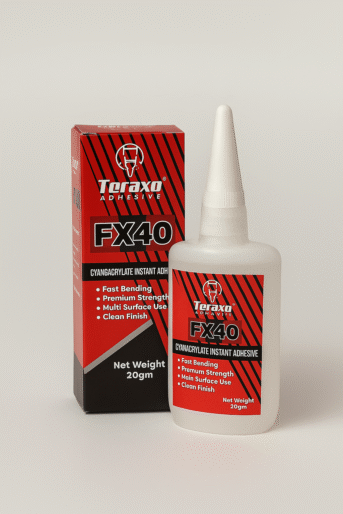- Your cart is empty
- Continue Shopping
Cyanoacrylate Adhesives: Uses, Benefits & Applications | Teraxo
When most people hear the term “super glue”, they think of a tiny tube of fast-bonding liquid that can stick almost anything together in seconds. In the industrial world, that glue has a formal name: cyanoacrylate adhesive (CA adhesive). It’s one of the most widely used bonding solutions today, finding applications across footwear, woodworking, electronics, automotive, medical, and even DIY projects.
Cyanoacrylate adhesives, commonly referred to as super glues, have transformed various industries due to their rapid bonding capabilities and versatility. For instance, in the footwear industry, cyanoacrylate is crucial for quickly assembling shoes, allowing manufacturers to produce finished products more efficiently. Additionally, in woodworking, these adhesives are often used for intricate projects where precision is essential, such as creating fine furniture or detailed crafts.
Furthermore, cyanoacrylate adhesives have distinct chemical properties that make them suitable for various applications. Their ability to bond different materials, such as metal to plastic or wood to ceramics, allows for innovative designs in product development. This versatility encourages manufacturers to experiment with new materials and technologies, leading to enhanced product performance and durability.
In this blog, we’ll break down what cyanoacrylate adhesives are, how they work, and why they’re so popular among manufacturers and everyday users.
🔬 What is Cyanoacrylate Adhesive?
Cyanoacrylate (CA) is a fast-acting adhesive that forms strong bonds with a wide range of materials. Unlike traditional glues, CA adhesives don’t need heat, clamping, or long curing times. Instead, they react with trace amounts of moisture on the surface to create an almost instant bond.
- Other Names: Instant glue, super glue, power glue
- Bonding Time: Usually within 5–30 seconds
- Common Substrates: Wood, leather, rubber, plastics, ceramics, and metals

⚙️ How Do Cyanoacrylate Adhesives Work?
The secret lies in chemistry.
Understanding the mechanism of cyanoacrylate adhesives can help users appreciate their unique properties. For example, the process of polymerization that occurs upon exposure to moisture not only allows for quick bonding but also creates a strong and resilient connection that withstands various environmental conditions. This is particularly beneficial in applications like automotive assembly, where durability and safety are paramount.
- Cyanoacrylate molecules remain liquid inside the tube.
- When applied to a surface, they come in contact with moisture (even humidity in the air).
- This triggers a rapid polymerization reaction — the molecules link together and solidify into a strong plastic mesh.
- The result? A rigid, high-strength bond that is resistant to temperature and stress.
✅ Key Benefits of Cyanoacrylate Adhesives
- Fast Bonding: Bonds in seconds, increasing productivity.
- Versatility: Works on multiple surfaces including porous (wood, leather) and non-porous (metal, glass).
- High Strength: Creates durable bonds capable of withstanding pressure and load.
- Easy to Use: No mixing, heating, or clamping required.
- Cost-Effective: Reduces production time and labor costs.
🏭 Applications of Cyanoacrylate Adhesives
Cyanoacrylates are used in almost every industry:
- Footwear Manufacturing: Bonding soles and leather parts.
- Woodworking & Furniture: Fast assembly of joints and parts.
- Electronics: Securing wires, plastic casings, and components.
- Automotive: Quick fixes, gasket sealing, and plastic parts bonding.
- Medical Industry: Special medical-grade CA adhesives are used for surgical wound closure.
- Everyday Use: Household repairs, DIY crafts, and quick fixes.
Moreover, cyanoacrylate adhesives are often favored for their ease of use. They require no special equipment or preparation, making them accessible for both professionals and DIY enthusiasts. For instance, a simple household repair can be accomplished in moments, enhancing consumer convenience without compromising quality. Additionally, the cost-effectiveness of these adhesives contributes to their widespread adoption, as businesses can save on production costs while maintaining high standards.
Final Thoughts
In conclusion, cyanoacrylate adhesives represent a remarkable advancement in bonding technology, offering unparalleled speed, strength, and versatility. From industrial applications to everyday repairs, their impact is significant and far-reaching. As innovation continues within this sector, cyanoacrylate adhesives will undoubtedly remain at the forefront, shaping the future of how materials are joined and utilized across numerous industries.
In practical applications, cyanoacrylate adhesives demonstrate remarkable reliability. For example, in the electronics industry, they are used to secure delicate components without adding significant weight or bulk to the device. This precision is crucial in modern electronics where space is at a premium, ensuring that devices remain sleek and functional.
A notable example of cyanoacrylate’s application is in the medical field, where specialized formulations are used for closing wounds. These medical-grade adhesives provide a sterile alternative to traditional sutures, reducing the risk of infection and promoting faster healing. Their use in surgeries showcases the adhesive’s strength and safety, highlighting its versatility in critical applications.
In the realm of DIY crafts, cyanoacrylate adhesives have gained popularity for their quick setting time and ability to bond various materials together seamlessly. Craft enthusiasts utilize these adhesives for projects ranging from model building to jewelry making, where precision and strength are essential.
Lastly, as industries evolve and new materials are developed, the formulation of cyanoacrylate adhesives continues to innovate. Manufacturers are now producing specialized adhesives that cater to specific needs, such as heat-resistant or water-resistant variations, broadening the scope of their applications and enhancing their effectiveness across various sectors.
